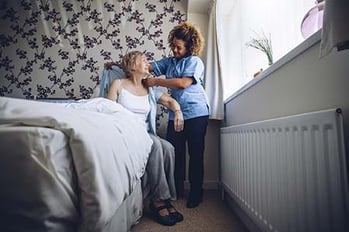
The big story for nursing home interior designers is how their work will help the largest and wealthiest generation
in history to transition into eldercare.
Boomers value experiences above all else, and will be happy to pay more for the comforts they enjoy. That means interior designers today are driven to create an environment for new residents that suits their tastes and needs.
Interior designers will play a critical role in helping promote wellness and quality of life among aging persons in the coming years. For designers, the big challenge is finding a balance between the community and creating a “sense of place” that connects with the individual. Here are some of the bigger trends to keep an eye on:
Bring the Outdoors In
From a high level, the biggest trend in nursing home design involves incorporating features that define various outdoor spaces into the community indoor environment. In essence, bringing into a facility those little touches make a neighborhood, a restaurant, or your own home unique and allowing them to make a space stand out from other spaces.
[Download Whitepaper: Long Term Management Solution for Healthcare Fabrics]
For many facilities, that means more clearly defining what is a space for eating, for recreation, and so on by using visual design cues. This may include small touches, like adding park benches, exterior siding, and other “outdoor” features to hallways to emphasize the cul-du-sac quality of the hallway.
Residents want to feel like they live in a home, not a hospital. Interior design is increasingly being used to define spaces and give residents a feeling that their community hasn’t changed so much since moving in. That also means personalizing a resident’s living space to meet their personal tastes. Fabric curtains can be chosen in a particular color or pattern to accentuate furniture and personal affects a resident brings with them — while also meeting hospital-grade safety standards.
Mobility-Centric Design
Seniors require special considerations when it comes to design. That extends beyond showers and stairs — everything that requires twisting or lifting can present a challenge to older folks.
This whitepaper by Perkins Eastman studied the effects of aging and sensory deprivation on mobility as it relates to simple tasks like using a door handle. Using their research, they helped design six prototype handles that fall into three categories: handles adapted from traditional forms, completely rethought handles, and handles for visionary new styles of door.
Innovation of this kind will only grow in popularity as the next major block of adults age into their golden years. Once we’ve rethought door handles, how can we rethink light switches, power outlets, cupboards, and more to make them easier for seniors to use?
Designers can start the mobility push early by selecting fixtures and features that are stylish and yet designed for people with limited eyesight and mobility.
New Dining Areas
Chefs choose a menu to create variety for their patrons. Why wouldn’t the dining space itself also offer some variety?
Another big trend in personalizing the nursing home experience is coming out of the kitchen. More facilities are moving away from cafeteria-style dining halls by offering a variety of dining options. In this way, residential facilities are moving offerings toward a hospitality approach, rather than a hospital approach.
Designers are using this inspiration to make dining spaces feel more like a restaurant. This can take a lot of different shapes, from smaller personal tables to on-table condiments to accent decor like curtains, fabric dividers, and tablecloths. A lot of facilities are now offering pick-and-grab style meals for quick, anytime eating — like you might get at a casual cafe. Sectioning a cafe area with curated furniture and design gives this space a look and feel separate from the other dining spaces.
Public Facing Amenities
There’s a big push for senior living centers to maintain strong ties with the community around them. BDC writes that “the boom of building more urban communities in 2017 is creating a push to integrate senior living communities into master-planned communities, where amenities like salons, dining areas, and fitness centers are public-facing to encourage increased socialization with the community at large.”
Placing social spaces closer to the community makes it easier for people with limited mobility to participate socially with residents and visitors alike. More designers are recommending that activity rooms and fitness centers, which increase mobility and overall well being, should be positioned centrally and toward the entrance so residents can easily access them.
Comforts for Staff, Too
Working in the nursing industry is physically and emotionally demanding. Recent research emphasizes the need to make staff feel supported by providing them spaces of their own to relax and socialize. A folding table in a drab room doesn’t just cut it. “Break rooms with lounge seating, as well as ping pong tables, full kitchens with free food, and sleep rooms are options that many are looking to provide to their staff,” according to Health Facilities Management. Happy staff equals happy residents.
Learn more about nursing home fabrics. Contact us!
